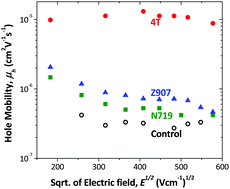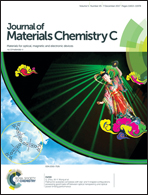Enhancement of hole mobility in hybrid titanium dioxide/poly(3-hexylthiophene) nanocomposites by employing an oligothiophene dye as an interface modifier†
Abstract
This study focuses on the influence of interface modifiers on the charge transport of hybrid nanoporous titanium dioxide (TiO2)/poly(3-hexylthiophene) (P3HT) nanocomposites by using the time of flight technique. We found that the hole-mobility in the nanocomposites is about three orders of magnitude less than that of pristine P3HT. This may be due to poor infiltration of the polymer into the highly structured porous TiO2 which in turn obstructs the charge transport of the carriers. However, the hole-mobility in the nanocomposites is increased by an order of magnitude when a ruthenium based dye, either Z907 or N719, is introduced at the TiO2/P3HT interface. Surprisingly, the electron-mobility of the composite is decreased upon dye treatment. We further observed that the hole-mobility of nanocrystalline TiO2/P3HT composites treated with a 3-hexylthiophene derivative with a cyanoacrylic acid group [(E)-2-cyano-3-(3′,3′′,3′′′-trihexyl-[2,2′:5′,2′′:5′′,2′′′-quaterthiophene]-5-yl)acrylicacid] (4T) increased to over 10−5 cm2 V−1 s−1, which is over an order of magnitude higher than the hole-mobility found in untreated nanocomposites. This trend in hole-mobility is consistent with corresponding current density (J)–voltage (V) characteristics under illumination of TiO2/P3HT devices with or without a dye interface layer. The higher hole-mobility found in the 4T dye treated TiO2/P3HT nanocomposite is assigned to passivation of surface traps by the dye as well as improved packing of the polymer with the nanocrystals through effective inter-chain interactions of 4T with P3HT.



 Please wait while we load your content...
Please wait while we load your content...